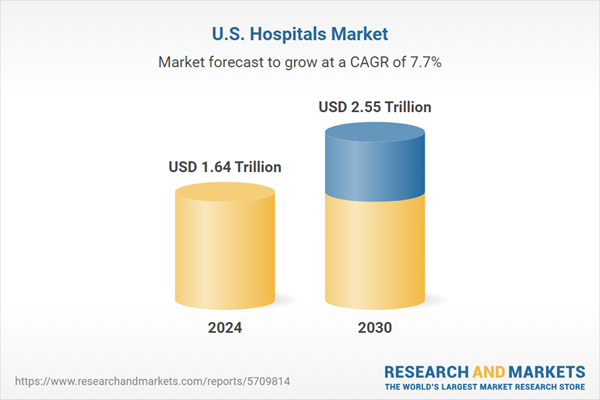Speak directly to the analyst to clarify any post sales queries you may have.
10% Free customizationThis report comes with 10% free customization, enabling you to add data that meets your specific business needs.
With rising healthcare utilization stemming from an aging population and increasing chronic disease prevalence, U.S. hospitals face heightened operational complexity and financial challenges. Simultaneously, the shift toward value-based care, greater focus on digital health solutions, and performance-based reimbursement models are reshaping how hospitals operate and deliver outcomes. Institutions that embrace innovation, optimize processes, and focus on measurable care outcomes are better positioned to thrive in this rapidly evolving landscape.
Key Market Drivers
Increasing Prevalence of Chronic Diseases and Aging Population
The expanding elderly demographic and rising incidence of chronic diseases are primary forces driving the growth of the U.S. hospitals market. Chronic health conditions such as cardiovascular disease, diabetes, cancer, and respiratory disorders are responsible for the majority of hospital admissions and long-term care expenses. Data from the Centers for Disease Control and Prevention (CDC) indicates that nearly 60% of American adults suffer from at least one chronic condition, while approximately 40% have two or more. These persistent health issues significantly increase the need for hospital-based care, intensive treatment protocols, and ongoing monitoring.As the U.S. population continues to age, the demand for geriatric services, specialized treatment pathways, and chronic care coordination is surging. Hospitals are adapting their service delivery models to accommodate this rising burden by expanding geriatric units, deploying care management teams, and adopting technology-enabled solutions to improve chronic disease outcomes.
Key Market Challenges
Rising Operational Costs and Financial Pressures
U.S. hospitals are grappling with mounting financial challenges due to escalating labor costs, inflationary pressures on medical supplies and equipment, and increased administrative demands. Persistent labor shortages - particularly in nursing, allied health, and specialty care - are contributing to wage hikes and operational disruptions. High fixed costs for maintaining facilities, upgrading equipment, and meeting regulatory compliance further strain budgets.Moreover, delays and reductions in reimbursements from both government programs and private insurers are impacting financial stability, especially for independent and rural hospitals. Many facilities are being forced to scale down operations, consolidate with larger networks, or close altogether. While cost-cutting measures and operational streamlining are being implemented, sustainable financial performance will ultimately require systemic reforms in healthcare funding and workforce development.
Key Market Trends
Shift Toward Value-Based and Patient-Centered Care
The transition from volume-driven to value-based care is a defining trend reshaping the U.S. hospital landscape. Under value-based models, hospitals are increasingly reimbursed based on patient outcomes, care quality, and overall efficiency rather than service volume. Programs like the Hospital Readmissions Reduction Program (HRRP) and bundled payment initiatives are encouraging care models that reduce unnecessary admissions, enhance chronic disease management, and prioritize preventive care.Hospitals are investing in technologies such as telemedicine, remote monitoring, and health analytics to improve care coordination and patient engagement. Patient satisfaction and health outcomes are becoming core metrics for financial incentives and reputation management. As this transformation continues, hospitals that adopt patient-centered strategies and innovative delivery models will gain competitive advantages in a results-driven healthcare environment.
Key Market Players
- HCA Healthcare, Inc.
- Ascension Health
- Tenet Healthcare Corporation
- Community Health Systems Inc.
- Catholic Health Initiatives
- Hospital Corporation of America
- LifePoint Health
- Prime Healthcare Services
- Universal Health Services, Inc.
- National Surgical Hospitals, Inc
Report Scope:
In this report, the United States Hospitals Market has been segmented into the following categories, in addition to the industry trends which have also been detailed below:United States Hospitals Market, By Ownership:
- Public
- Private
United States Hospitals Market, By Type:
- General
- Specialty
- Multi-Specialty
United States Hospitals Market, By Type of Service:
- In-Patient Services
- Out-Patient Services
United States Hospitals Market, By Bed Capacity:
- Up to 100 beds
- 100-500 beds
- Above 500 beds
United States Hospitals Market, By Region:
- North-east
- Mid-west
- West
- South
Competitive Landscape
Company Profiles: Detailed analysis of the major companies present in the United States Hospitals Market.Available Customizations:
With the given market data, the publisher offers customizations according to a company's specific needs. The following customization options are available for the report.Company Information
- Detailed analysis and profiling of additional market players (up to five).
This product will be delivered within 1-3 business days.
Table of Contents
Companies Mentioned
- HCA Healthcare, Inc.
- Ascension Health
- Tenet Healthcare Corporation
- Community Health Systems Inc.
- Catholic Health Initiatives
- Hospital Corporation of America
- LifePoint Health
- Prime Healthcare Services
- Universal Health Services, Inc.
- National Surgical Hospitals, Inc
Table Information
| Report Attribute | Details |
|---|---|
| No. of Pages | 85 |
| Published | June 2025 |
| Forecast Period | 2024 - 2030 |
| Estimated Market Value ( USD | $ 1.64 Trillion |
| Forecasted Market Value ( USD | $ 2.55 Trillion |
| Compound Annual Growth Rate | 7.6% |
| Regions Covered | United States |
| No. of Companies Mentioned | 10 |









